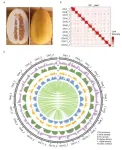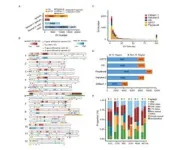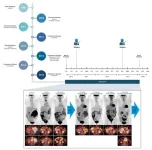(Press-News.org)
Melon (Cucumis melo L.) is an important vegetable crop that has an extensive history of cultivation, and has been classified into two subspecies, C. melo ssp. agrestis and C. melo ssp. melo. Previous study suggested that the two subspecies were domesticated independently [1], which may have generated different genetic mechanisms for the same trait between the two subspecies. Furthermore, the difference in their geographical distribution resulted in diverse characteristics between the two subspecies, shaping genomic imprinting in their genomes. Wild germplasm is an important genetic resource in crop breeding because of its high genetic diversity and resistance against diseases. However, all of the previous reported genomes were assembled based on the cultivated melon[2-7], the genome of wild and semi-wild melon types is not yet available. Therefore, assembling high-quality wild/semi-wild melon genome will provide an unprecedented opportunity for gene discovery and resistance breeding in melon.
Recently, the study of ‘The haplotype resolved T2T reference genome highlights structural variation underlying agronomic traits of melon’ was published on Horticulture Research by Yongyang Xu, from Melon Genetic Breeding Team of Zhengzhou Fruit Research Institute, Chinese Academy of Agricultural Sciences, cooperated with professor Tao Lin from China Agricultural University.
PI 313970 is an accession derived from C. melo ssp. agrestis var. acidulus native to India, which possess high resistance to powdery mildew and a variety of viral diseases (ToLCNDV, CYSDV, CABYV, WmCSV and CuLCrV). The ‘821’ accession was self-fertilized from PI 313970 for several generations. Here we reported a chromosome-level T2T genome assembly for 821 (C. melo ssp. agrestis var. acidulus), a semi-wild melon with two haplotypes of ~373 Mb and ~364 Mb, respectively (Fig.1).
Comparative genome analysis discovered a significant number of structural variants (SVs) between melo and agrestis genomes, including a copy number variation located in the ToLCNDV resistance locus on chromosome 11, of which a candidate gene was identified for ToLCNDV resistance (Fig. 2). Additionally, melon is a unique model species for studying fruit ripening because of presenting both climacteric and non-climacteric types. Genome-wide association studies detected a significant signal associated with climacteric ripening and identified one candidate gene CM_ac12g14720.1 (CmABA2), encoding a cytoplasmic short chain dehydrogenase/reductase, which controls the biosynthesis of abscisic acid. This study provides valuable genetic resources for future research on resistance breeding in melon.
References
Zhao, G. et al. (2019) A comprehensive genome variation map of melon identifies multiple domestication events and loci influencing agronomic traits. Nat Genet 51, 1607-1615.
Garcia-Mas J et al. (2012) The genome of melon (Cucumis melo L.). PNAS 109, 11872-11877.
Yang, J.H. et al. (2020) The chromosome-scale genome of melon dissects genetic architecture of important agronomic traits. iScience 23, 101422.
Zhang, H. et al. (2019) A high-quality melon genome assembly provides insights into genetic basis of fruit trait improvement. iScience 22, 16-27.
Pichot, C. et al. (2022) Cantaloupe melon genome reveals 3D chromatin features and structural relationship with the ancestral cucurbitaceae karyotype. iScience 25, 103696.
Ling, J. et al. (2021) High-quality chromosome-level genomes of Cucumis metuliferus and Cucumis melo provide insight into Cucumis genome evolution. Plant J 107, 136-148.
Castanera, R. et al. (2019) An improved melon reference genome with Single-Molecule Sequencing Uncovers a recent burst of transposable elements with potential impact on genes. Front Plant Sci 10, 1815.
###
Authors
Guoli Li1,2#, Lingli Tang1,3,4#, Yuhua He1,3, Yongyang Xu1,3, Abdelhafid Bendahmane5, Jordi Garcia-Mas6,7, Tao Lin2*, Guangwei Zhao1,3,4*
Affiliations
1. National Key Laboratory for Germplasm Innovation & Utilization of Horticultural Crops, Zhengzhou Fruit Research Institute, Chinese Academy of Agricultural Sciences, Zhengzhou, Henan, 450009, China.
2. China Agricultural University, College of Horticulture, Beijing 100193, China.
3. National Nanfan Research Institute (Sanya), Chinese Academy of Agricultural Sciences, Sanya Hainan, 572024, China
4. Zhongyuan Research Center, Chinese Academy of Agricultural Sciences, Xinxiang 453400, China.
5. Institute of Plant Sciences Paris-Saclay (IPS2), INRAE, CNRS, University of Paris-Saclay, University of Evry, University of Paris-Diderot, Gif sur Yvette 91192, France.
6. Centre for Research in Agricultural Genomics (CRAG) CSIC-IRTA-UAB-UB, Edifici CRAG, Campus UAB, 08193 Bellaterra, Barcelona, Spain.
7. Institut de Recerca i Tecnologia Agroalimentàries (IRTA), Edifici CRAG, Campus UAB, 08193 Bellaterra, Barcelona, Spain.
About Guangwei Zhao
Guangwei Zhao, Doctor, doctoral supervisor, engaged in melon genetic breeding, E-mail: zhaoguangwei@caas.cn
END
Pregnant women living in blighted neighborhoods with high levels of known stressors have higher levels of testosterone – the primary sex hormone in males -- which disrupt hormone regulation and may lead to life-threatening complications during and after childbirth, according to Rutgers research.
“Previous research has shown that exposure to neighborhood stressors is associated with preterm birth, low birth weight and other complications such as preeclampsia, gestational diabetes and stillbirth,” ...
Highlights
Investigators have found demographic differences between participants of kidney transplant clinical trials and transplant recipients in the United States, even in recent years.
Results from the study will be presented at ASN Kidney Week 2023 November 1–November 5.
Philadelphia, PA (November 3, 2023) — Investigators recently examined the extent to which participants in clinical trials related to kidney transplantation are similar to individuals undergoing transplantation in the United States. The ...
Highlights
In a recent analysis of US data, Black patients with kidney failure experienced survival advantages compared with White patients when county-level structural racism was low, but they experienced survival disadvantages compared with White patients at higher levels of structural racism.
Results from the study will be presented at ASN Kidney Week 2023 November 1–November 5.
Philadelphia, PA (November 3, 2023) — A new analysis indicates that county-level structural racism is a significant determinant of death among individuals ...
Highlights
Imaging tests in individuals with type 2 diabetes without symptoms of cardiovascular disease indicated that elevated albumin in the urine may be linked with sub-clinical coronary artery pathology, including coronary artery microcalcifications.
Results from the study will be presented at ASN Kidney Week 2023 November 1–November 5.
Philadelphia, PA (November 3, 2023) — Advances in non-invasive imaging have allowed clinicians to assess both the structure and function of coronary arteries. Investigators who recently used positron emission tomography and computed tomography ...
Highlights
By examining the gene expression patterns of single cells from human fetal kidneys, researchers created a map that demonstrates the trajectories of cell states in the developing kidney and that identifies characteristics associated with kidney diseases.
Results from the study will be presented at ASN Kidney Week 2023 November 1–November 5.
Philadelphia, PA (November 3, 2023) — Scientists have examined the gene expression patterns of single cells from 5 human fetal kidneys to create the most complete atlas of the ...
Highlights
Results from the phase 3 SCORED trial indicate that sotagliflozin protects kidney and heart health in individuals with type 2 diabetes and chronic kidney disease.
Results from the study will be presented at ASN Kidney Week 2023 November 1–November 5.
Philadelphia, PA (November 3, 2023) — Sodium-glucose cotransporter-2 (SGLT2) inhibitors, which are medications that lower blood sugar levels among other effects, provide kidney- and heart-related benefits to patients with and without diabetes. An exploratory analysis ...
Alaskans and visitors may be able to see an artificial airglow in the sky created by the High-frequency Active Auroral Research Program during a four-day research campaign that starts Saturday.
Scientists from the University of Alaska Fairbanks, Cornell University, University of Colorado Denver, University of Florida and Georgia Institute of Technology will conduct a variety of experiments at the UAF-operated research site.
The experiments will focus on the ionosphere, the region of the atmosphere between about 30 and 350 miles ...
“The patient was managed with ripretinib and surgical resection of progressing lesions at multiple time points which led to extended clinical benefit.”
BUFFALO, NY- November 3, 2023 – A new case report was published in Oncoscience (Volume 10) on September 20, 2023, entitled, “Multi-disciplinary management of recurrent gastrointestinal stromal tumor harboring KIT exon 11 mutation with the switch-control kinase inhibitor ripretinib and surgery.”
Ripretinib is a tyrosine kinase inhibitor that was approved by the United States FDA in 2020 for treatment of advanced ...
Health happens where people work, live, play and worship, says Prof. Stacey Snelling, chair of the Department of Health Studies in American University’s College of Arts and Sciences. And that’s where the Healthy Schools, Healthy Communities Lab engages children, adults and older adults to tackle health inequities. Snelling received a three-year grant of $2.8 million from Novo Nordisk Inc. for health education and to grow the number of Black farmers producing locally grown fruit and vegetables. The goal is to improve local ...
BOSTON – Ready or not, patients with cancer are increasingly likely to find themselves interacting with artificial intelligence technologies to schedule appointments, monitor their health, learn about their disease and its treatment, find support, and more. In a new paper in JCO Oncology Practice, bioethics researchers at Dana-Farber Cancer Institute call on medical societies, government leaders, clinicians, and researchers to work together to ensure AI-driven healthcare preserves patient autonomy and respects human dignity.
The authors note that while AI has immense potential for expanding access to cancer care and improving the ...


